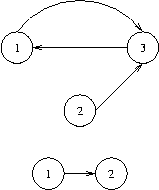POJ2553( 有向图缩点)
2024-09-07 04:27:05
The Bottom of a Graph
| Time Limit: 3000MS | Memory Limit: 65536K | |
| Total Submissions: 9779 | Accepted: 4063 |
Description
We will use the following (standard) definitions from graph theory. Let V be a nonempty and finite set, its elements being called vertices (or nodes). Let E be a subset of the Cartesian product V×V, its elements being called edges. Then G=(V,E) is called a directed graph.
Let n be a positive integer, and let p=(e1,...,en) be a sequence of length n of edges ei∈E such that ei=(vi,vi+1) for a sequence of vertices (v1,...,vn+1). Then p is called a path from vertex v1 to vertex vn+1 in Gand we say that vn+1 is reachable from v1, writing (v1→vn+1).
Here are some new definitions. A node v in a graph G=(V,E) is called a sink, if for every node w in G that is reachable from v, v is also reachable from w. The bottom of a graph is the subset of all nodes that are sinks, i.e., bottom(G)={v∈V|∀w∈V:(v→w)⇒(w→v)}. You have to calculate the bottom of certain graphs.
Let n be a positive integer, and let p=(e1,...,en) be a sequence of length n of edges ei∈E such that ei=(vi,vi+1) for a sequence of vertices (v1,...,vn+1). Then p is called a path from vertex v1 to vertex vn+1 in Gand we say that vn+1 is reachable from v1, writing (v1→vn+1).
Here are some new definitions. A node v in a graph G=(V,E) is called a sink, if for every node w in G that is reachable from v, v is also reachable from w. The bottom of a graph is the subset of all nodes that are sinks, i.e., bottom(G)={v∈V|∀w∈V:(v→w)⇒(w→v)}. You have to calculate the bottom of certain graphs.
Input
The input contains several test cases, each of which corresponds to a directed graph G. Each test case starts with an integer number v, denoting the number of vertices of G=(V,E), where the vertices will be identified by the integer numbers in the set V={1,...,v}. You may assume that 1<=v<=5000. That is followed by a non-negative integer e and, thereafter, e pairs of vertex identifiers v1,w1,...,ve,we with the meaning that (vi,wi)∈E. There are no edges other than specified by these pairs. The last test case is followed by a zero.
Output
For each test case output the bottom of the specified graph on a single line. To this end, print the numbers of all nodes that are sinks in sorted order separated by a single space character. If the bottom is empty, print an empty line.

Sample Input
3 3
1 3 2 3 3 1
2 1
1 2
0
Sample Output
1 3
2
题意:给定一幅有向图,若某点所能到达的点也能到达其本身,那么这个点为sink。由小到大输出sink.
思路:有向图缩点得到一棵树,答案为构成叶子(出度为0)结点的连通分量。
#include<cstdio>
#include<cstring>
#include<algorithm>
#include<vector>
using namespace std;
const int MAXN=;
vector<int> mp[MAXN];
int n,m;
int dfn[MAXN],low[MAXN],time;
int stack[MAXN],top;
bool ins[MAXN];
int belong[MAXN],cnt;
void dfs(int u)
{
dfn[u]=low[u]=++time;
stack[top++]=u;
ins[u]=true;
for(int i=;i<mp[u].size();i++)
{
int v=mp[u][i];
if(!dfn[v])
{
dfs(v);
low[u]=min(low[u],low[v]);
}
else if(ins[v]) low[u]=min(low[u],dfn[v]);
}
if(dfn[u]==low[u])
{
int v;
cnt++;
do{
v=stack[--top];
belong[v]=cnt;
ins[v]=false;
}while(u!=v);
}
}
int deg[MAXN];
bool flag[MAXN];
void solve()
{
/*
for(int i=1;i<=n;i++)
printf("%d\n",belong[i]);*/ for(int i=;i<=n;i++)
for(int j=;j<mp[i].size();j++)
{
int v=mp[i][j];
if(belong[i]!=belong[v])
{
deg[belong[i]]++;
}
}
for(int i=;i<=cnt;i++)
if(deg[i]==)
flag[i]=true; for(int i=;i<=n;i++)
if(flag[belong[i]])
printf("%d ",i);
printf("\n");
}
int main()
{
while(scanf("%d",&n)!=EOF&&n)
{
scanf("%d",&m);
memset(dfn,,sizeof(dfn));
memset(low,,sizeof(low));
memset(ins,false,sizeof(ins));
memset(deg,,sizeof(deg));
memset(flag,false,sizeof(flag));
top=;
time=;
cnt=;
for(int i=;i<=n;i++)
mp[i].clear();
for(int i=;i<m;i++)
{
int u,v;
scanf("%d%d",&u,&v);
mp[u].push_back(v);
}
for(int i=;i<=n;i++)
if(!dfn[i])
dfs(i);
solve();
}
}
下面是kosaraju算法
#include"cstdio"
#include"cstring"
#include"vector"
using namespace std;
const int MAXN=;
vector<int> G[MAXN];
vector<int> rG[MAXN];
vector<int> vs;
int V,E; int cpnt[MAXN];
int vis[MAXN];
void dfs(int u)
{
vis[u]=;
for(int i=;i<G[u].size();i++)
if(!vis[G[u][i]]) dfs(G[u][i]);
vs.push_back(u);
} void rdfs(int u,int k)
{
cpnt[u]=k;
vis[u]=;
for(int i=;i<rG[u].size();i++)
if(!vis[rG[u][i]]) rdfs(rG[u][i],k);
} void scc()
{
memset(vis,,sizeof(vis));
for(int i=;i<=V;i++)
if(!vis[i]) dfs(i);
memset(vis,,sizeof(vis));
int k=;
for(int i=vs.size()-;i>=;i--)
if(!vis[vs[i]]) rdfs(vs[i],k++);
} int deg[MAXN];
void solve()
{
scc();
for(int i=;i<=V;i++)
{
for(int j=;j<G[i].size();j++)
{
int to=G[i][j];
if(cpnt[i]!=cpnt[to])
{
deg[cpnt[i]]++;
}
}
}
int flag=;
for(int i=;i<=V;i++)
{
if(deg[cpnt[i]]==)
{
if(flag==)
{
printf("%d",i);
flag=;
}
else
{
printf(" %d",i);
}
}
}
printf("\n");
}
int main()
{
while(scanf("%d",&V)!=EOF&&V)
{
scanf("%d",&E);
vs.clear();
memset(cpnt,,sizeof(cpnt));
memset(deg,,sizeof(deg));
for(int i=;i<=V;i++)
{
G[i].clear();
rG[i].clear();
}
for(int i=;i<E;i++)
{
int u,v;
scanf("%d%d",&u,&v);
G[u].push_back(v);
rG[v].push_back(u);
}
solve();
} return ;
}
最新文章
- .NET 基础一步步一幕幕[方法、结构、枚举]
- WPScan用法
- Linux关于vm虚拟机复制后无法启动网卡
- Centos 部署Keepalive高可用软件
- AutoHotKey使用:空格键坏了怎么办?
- poj 2723
- poj 动态规划题目列表及总结
- greenplum学习
- SQL高级查询的练习题
- EditText默认不弹出软键盘
- IT轮子系列(三)——如何给返回类型添加注释——Swagger的使用(二)
- hessian在ssh项目中的配置
- js中let和var的区别 不懂得加QQ 2270312758
- DG_Check检测
- 使用IntelliJ IDEA 配置Maven
- Java实现敏感词过滤 - IKAnalyzer中文分词工具
- Python_函数_参数
- LightOJ 1030 【概率DP求期望】
- Android开发之自定义的ProgressDialog
- 使用Inno Setup Compiler制作安装软件包